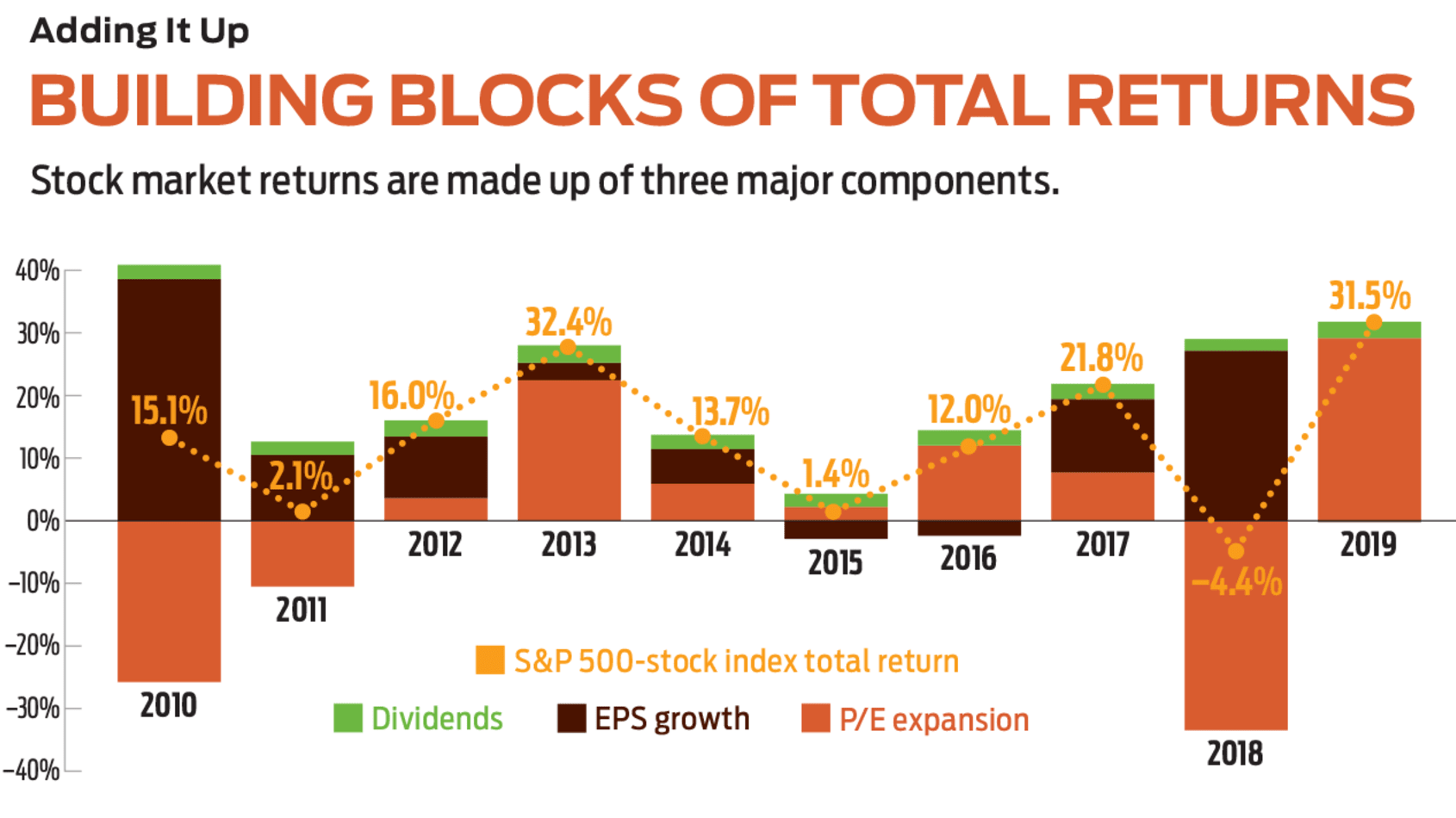What Drives Stock Returns?
Hint: It’s more than just company profits.


We’re told over and over that growth in corporate earnings drives stock market returns. If that’s the case, what has been going on lately? In 2019, Standard & Poor’s 500-stock index posted a total return of 32%, but corporate earnings barely moved. In 2018, with corporate profits solidly up, the market surrendered 4.4%. The truth is, earnings are only part of the picture when it comes to stock market returns. Understanding the whole mosaic can give you insight on how to manage your portfolio.
You can divide stock returns into three primary drivers, which can work in concert or at odds: earnings growth, valuation and dividends. In a vacuum, earnings growth is the easiest to understand. Say a stock costs $100 per share and posts earnings of $10 per share. If earnings grow by 5%, to $10.50, then the stock price should grow by a commensurate 5%, to $105, producing a 5% return.
But stock prices reflect what investors expect in the future. Their confidence or negativity about a stock’s potential is expressed in its valuation, commonly represented by a measure such as the price-earnings ratio. If investors are bullish on a stock, they’ll bid up the price, thus “expanding” the stock’s price-earnings multiple and boosting return.

Sign up for Kiplinger’s Free E-Newsletters
Profit and prosper with the best of expert advice on investing, taxes, retirement, personal finance and more - straight to your e-mail.
Profit and prosper with the best of expert advice - straight to your e-mail.
Say the $100 stock with $10 in earnings has a P/E of 10. Should confident investors bid the price up to 12 times earnings, the stock would now trade at $120, a 20% return. In 2019, 29 percentage points of the S&P 500’s 32% return came from valuation expansion. “Valuation expansion last year was in anticipation of earnings growth this year,” says analyst Willie Delwiche, at investment firm Baird.
Understanding where the market’s valuation stands compared with historical averages can give investors a sense of market risk, says Delwiche, because valuations tend to revert to mean levels over time. At 18 times expected year-ahead earnings, the S&P 500 trades above the 10-year average of 15. That doesn’t mean prices will come down imminently, Delwiche says, but it could signify that investors should explore less-volatile pockets of the market or consider investing overseas, where stocks are trading closer to historical norms.
Count on dividends. Income investors know the power of the third major driver of total returns: dividends. Since 1955, earnings growth has contributed 63% of the S&P 500’s total annual return, on average, followed by dividend payments (28%) and expansions or contractions in valuation (9%), according to Calamos Wealth Management.

Of those factors, dividends are the least volatile and don’t ever detract from the market’s return. As a result, reinvested dividends have an outsize impact on the market’s return over time. From the end of 1970 through 2019, 78% of the total return of the S&P 500 came from the compound growth of reinvested dividends, according to analysts at the Hartford Funds. The message is clear, says CFRA investment chief Sam Stovall: “Dividends reward the buy-and-hold investor.”
What will drive returns in 2020? Calamos Wealth Management chief investment officer Reed Murphy believes the baseline case is for valuations to hold relatively steady and for earnings growth for companies in the S&P 500 to come in below current estimates of 9%-plus. He suggests the S&P 500 is likely to return 7% to 8% in 2020, including a 1.9% dividend yield.
Get Kiplinger Today newsletter — free
Profit and prosper with the best of Kiplinger's advice on investing, taxes, retirement, personal finance and much more. Delivered daily. Enter your email in the box and click Sign Me Up.

Ryan joined Kiplinger in the fall of 2013. He wrote and fact-checked stories that appeared in Kiplinger's Personal Finance magazine and on Kiplinger.com. He previously interned for the CBS Evening News investigative team and worked as a copy editor and features columnist at the GW Hatchet. He holds a BA in English and creative writing from George Washington University.
-
 5 Easy Weatherproofing Projects That Help Prevent Damage and Save on Insurance
5 Easy Weatherproofing Projects That Help Prevent Damage and Save on InsuranceProtect your home from storms and water damage with these simple weatherproofing upgrades — some may help reduce your home insurance premium.
By Paige Cerulli
-
 If Trump Fires Jerome Powell, What Happens To Savings and Mortgage Rates?
If Trump Fires Jerome Powell, What Happens To Savings and Mortgage Rates?President Donald Trump expressed his desire to remove Fed Chair Jerome Powell. If the president is successful, how would it impact your savings accounts?
By Sean Jackson
-
 Stock Market Today: No 'Powell Put'? No Problem
Stock Market Today: No 'Powell Put'? No ProblemInvestors, traders and speculators look beyond both another Trump post and more signs of slowing economic activity.
By David Dittman
-
 Stock Market Today: Dow Drops 699 Points After Powell Speech
Stock Market Today: Dow Drops 699 Points After Powell SpeechFed Chair Powell warned of a slowing economy and higher inflation but said the central bank isn't ready to cut rates just yet.
By Karee Venema
-
 Stock Market Today: Stocks Struggle Amid Tariff Uncertainty
Stock Market Today: Stocks Struggle Amid Tariff UncertaintyBoeing dropped after China suspended new aircraft orders, while Bank of America and Citi climbed on earnings beats.
By Karee Venema
-
 Stock Market Today: Stocks Gain on Tech, Auto Tariff Talk
Stock Market Today: Stocks Gain on Tech, Auto Tariff TalkThe Trump administration said late Friday that it will temporarily halt tariffs on some Chinese tech imports.
By Karee Venema
-
 Stock Market Today: Stocks Surge to Close a Volatile Week
Stock Market Today: Stocks Surge to Close a Volatile WeekIt was another day with a week's worth of both news and price action, but it ended on a strongly positive note.
By David Dittman
-
 Stock Market Today: Uncertainty Proliferates: Dow Loses 1,014 Points
Stock Market Today: Uncertainty Proliferates: Dow Loses 1,014 PointsWeaker-than-expected consumer inflation data wasn't enough to stabilize sentiment during another volatile day for financial markets.
By David Dittman
-
 Stock Market Today: Tariff Pause Triggers 3,000-Point Dow Rally
Stock Market Today: Tariff Pause Triggers 3,000-Point Dow RallyThe bond market is sending concerning signals as the Trump administration executes its rapid reordering of global trade relationships.
By David Dittman
-
 Stock Market Today: Tariff Talks Drive Another Up-and-Down Day
Stock Market Today: Tariff Talks Drive Another Up-and-Down DayTrade war negotiations are happening, but the "fear gauge" is gyrating, and investors, traders and speculators are still searching for signs of a bottom.
By David Dittman